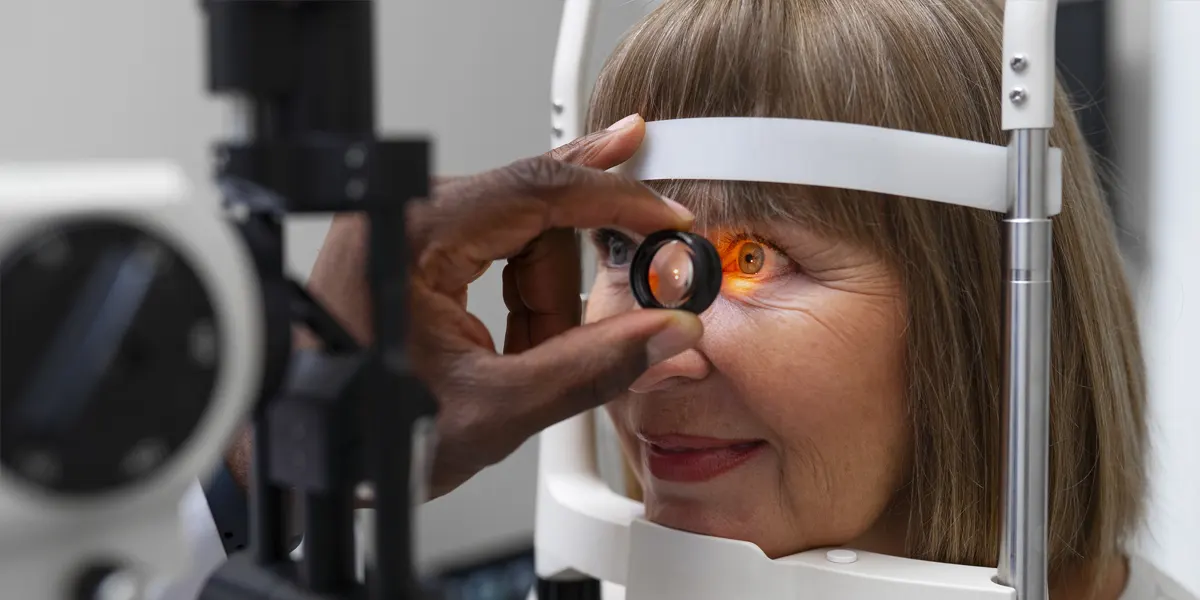
What is argon laser trabeculoplasty (ALT)?
Argon laser trabeculoplasty (ALT) is an in-office laser procedure used to treat open-angle glaucoma. This type of glaucoma usually occurs due to high eye pressure. The fluid in the front of the eye — the aqueous humor — is not draining properly. ALT helps increase the drainage to lower eye pressure.
This surgery is similar to selective laser trabeculoplasty (SLT). Both procedures use a laser to improve aqueous humor outflow through a spongy drainage meshwork in the eye, lowering eye pressure.
ALT uses a higher-energy laser than SLT. The lower-energy laser used during SLT is absorbed by only particular pigmented tissue in the eye. As a result, SLT usually has less scarring and allows for multiple treatments if needed. ALT does not allow for repeated treatments.
Glaucoma surgery can help lower the pressure inside the eye in people with glaucoma. When the pressure in the eye is too high, the risk of vision loss increases due to damage to the optic nerve, which sends signals from the eye to the brain. Glaucoma surgery cannot recover lost vision but can help prevent further vision loss.
U.C.P(Ultrasound Cycloplasty)
Ultrasound cycloplasty (UCP) is a non-incisional procedure that utilizes high-intensity focused ultrasound (HIFU) to reduce intraocular pressure (IOP) in patients with glaucoma.
- It is effective for both refractory and non-refractory glaucoma cases where traditional surgery may not be suitable.
- The technique involves controlled thermal coagulation of the ciliary body, leading to a decrease in aqueous humor production, which helps lower IOP.
- Studies have shown that UCP is safe and effective for treating advanced or refractory glaucoma.
- Trabeculectomy (tra-BECK-yoo-LECK-toh-mee)
- Glaucoma implant surgery
- Minimally invasive glaucoma surgery (MIGS)
This innovative approach offers a promising alternative for managing glaucoma in patients who may not respond well to conventional treatments.
GLAUCOMA SURGERIES
If glaucoma medicines and laser treatment haven’t helped to treat your glaucoma, your doctor may recommend surgery. Surgery can’t cure glaucoma or undo vision loss, but it can help protect your vision and stop it from getting worse.
There are a few different types of surgery for glaucoma that can help lower the pressure in your eye:
If you need glaucoma surgery in both eyes, your doctor will only do surgery on 1 eye at a time.
What is trabeculectomy?
This type of surgery is usually used to treat open-angle glaucoma. It’s done in a hospital and usually takes less than an hour.
The surgeon will create a tiny opening in the top of your eye. The opening will be under your eyelid, where no one will see it. This opening allows extra fluid in your eye to drain away, lowering pressure in your eye.
Usually, you’ll be awake during this surgery — but you’ll get numbing medicine and medicine to help you relax. You can usually go home the same day, but you’ll need someone to drive you home.
What is glaucoma implant surgery?
This type of surgery is used to treat several types of glaucoma, including congenital glaucoma, neovascular glaucoma, and glaucoma caused by an injury. It’s done in a hospital and usually takes 1 to 2 hours.
In this operation, the surgeon implants a tiny tube, or shunt, onto the white part of your eye. The tube helps extra fluid drain out of your eye, lowering your eye pressure.
Usually, you’ll be awake during this surgery — but you’ll get numbing medicine and medicine to help you relax. You can usually go home the same day, but you’ll need someone to drive you home.
What is minimally invasive glaucoma surgery (MIGS)?
If you have mild glaucoma, your doctor may recommend a new approach called minimally invasive glaucoma surgery (MIGS). This also lowers eye pressure, but it has fewer risks and side effects and helps you recover faster.
There are different types of MIGS, so ask your eye doctor about whether MIGS may be an option for you.
What happens after surgery?
Your doctor will prescribe eye drops to help prevent swelling and infections, and you’ll need to use them for several weeks. These eye drops are different from other glaucoma eye drops you may already use.
While you recover, you may need to avoid some activities for 2 to 4 weeks, like lifting anything heavy. You’ll also need check-ups with your doctor to make sure your eye is healing well.
Will I need surgery again?
For some people, the benefits of surgery last a long time. For others, the opening in the eye begins to close up and they need surgery again. You’ll need regular check-ups with your doctor to test your eye pressure. That way, your doctor will be able to act fast if you need more treatment.
Research shows that trabeculectomy can lower eye pressure in about 7 out of 10 people. It may work best in people who haven’t had an eye injury or another eye surgery.
What are the side effects of surgery for glaucoma?
Glaucoma surgery can have side effects, just like any operation. For example, your eye may be swollen and sore for a while.
Other possible risks of glaucoma surgery include:
- Cataract
- Problems with the cornea (the clear front layer of your eye)
- Eye pressure that’s too low
- Vision loss
Talk over the pros and cons of surgery with your doctor. Together, you can make a treatment plan that’s right for you.
